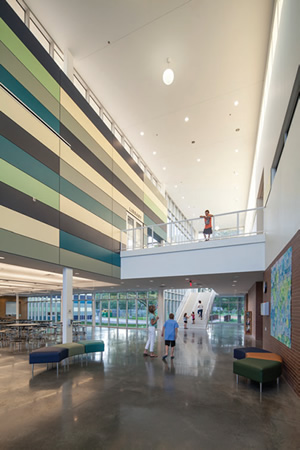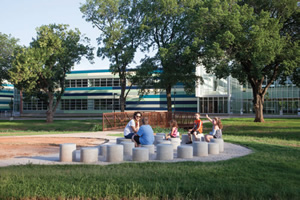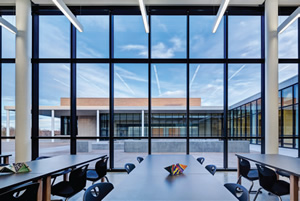'Wow, you really like me!'

PHOTOS COURTESY OF STILLWATER PUBLC SCHOOLS - WILL ROGERS ELEMENTARY SCHOOL
When we think of the tools we use to help our children learn and grow at school, we think of textbooks, SMART boards and multiplication tables. But what if the school itself were a powerful learning tool, capable of creating the kind of positive, secure and engaging atmosphere children need to succeed?
The physical environment of our schools plays an important role in how our students feel and educators function. Seemingly small details such as controlled daylight, a connection with the outdoors, and interactive gathering spaces all contribute to a bright, positive atmosphere that could greet students and teachers each morning.
Thoughtful design inspires thoughtfulness. Safe, secure environments build confidence. Bright, sunlit spaces make students shine. What if every school was a place students were excited to come to each morning, ready to excel?
Many of us have never experienced firsthand a learning environment that looks and feels like this. I certainly remember a time when classrooms contained a dusty chalkboard, a sea of small desks and the position of the minimal windows determined the temperature in the room.

PHOTOS COURTESY OF STILLWATER PUBLC SCHOOLS - WILL ROGERS ELEMENTARY SCHOOL
The demand for a better learning environment is here. The way we communicate, learn, and explore has changed. How we educate our students today is rooted in unprecedented knowledge of how to adapt to a variety of learning styles and is supported by innovative technology.
It’s time to transform our learning environments to engage and inspire our students. It’s time to reinvest in our commitment to the success of our communities.
Architectural design for schools comes with its own set of responsibilities, including adequate capacity, affordable maintenance and extensive safety features. How do we begin to transform our schools in a way that will make the biggest impact? Here are five important keys to a successful school environment.

PHOTOS COURTESY OF BROKEN ARROW PUBLC SCHOOLS - FRESHMAN ACADEMY
- Indoor Air Quality — Poor indoor air quality can trigger absences and affect concentration. As densely populated places, schools need excellent indoor air quality.
- Acoustics — Students shouldn’t miss important classroom content due to background noise, such as from heating and cooling systems. Young children require a high level of acoustic quality for comprehension.
- Visual Comfort — Research shows appropriate lighting improves test scores and reduces behavioral issues. Superbly illuminated spaces simply create a positive environment.
- Sustainable Design — A high-performance school is synonymous with a sustainable school. Sustainable design maximizes tax dollars, conserves resources and cuts operating costs – while teaching environmental responsibility.
- Flexibility — Students learn in different ways. Today’s classrooms need more flexibility and a creative learning environment so that several activities can go on simultaneously.

PHOTOS COURTESY OF STILLWATER PUBLC SCHOOLS - HIGHLAND PARK ELEMENTARY SCHOOL
In a good place. Thoughtful design inspires thoughtfulness. Safe, secure environments build confidence. Bright, sunlit spaces make students shine. This is why we need to create learning spaces with an atmosphere that lets students know they are cared for and capable of great things. It has been proven that students in these types of spaces exhibit improved academic performance.
Creating an atmosphere that lets students know they are cared for and capable of great things, that is something our educators strive for each and every day, why not insist the school building itself do the same thing? In schools that have addressed these key issues, their students not only exhibit improved academic performance, but have better attendance and behavior as well.
“I was greeting students on the first day of school as they entered our new Highland Park Elementary. There is so much light in the beautiful atrium — very different from the old building. As I stood there, a first-grade boy walked in with nine family members. He stepped into the lobby, looked up and said, ‘Wow, you really like me!’ Then he continued to look around in awe, as did his family,” says former Stillwater Public Schools Superintendent Ann Caine, Ed.D. “I was so choked up. This is why we do what we do. Facilities DO make a difference. Highland Park has told me behavior is calmer because the students are taking pride in their new building. Achievement is up. Teachers are excited to come to work every day because they are teaching in aesthetically pleasing rooms with plenty of storage!”
Across the country, communities are voting on school bond campaigns. Many of these campaigns focus on building and improving facilities and classrooms. It is within our power as taxpayers to maximize all of our powerful learning tools to strengthen both our schools and our communities.
This article originally appeared in the issue of .
About the Author
Janet Selser is an architect and the co-founder and president of Selser Schaefer Architects in Tulsa. Selser Schaefer Architects (www.selserschaefer.com) draws upon years of experience and evidencebased best practices to design environments that support education — making sure nothing gets in the way of the connections that spark learning.